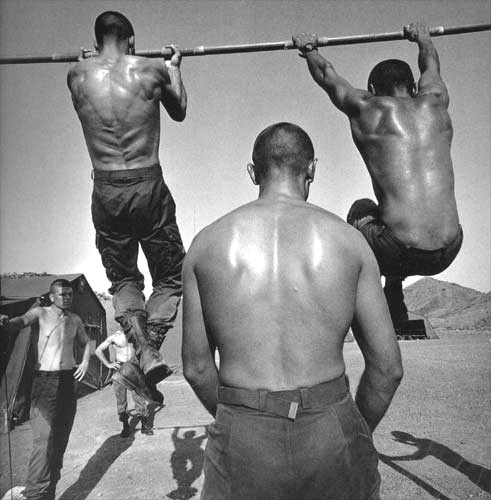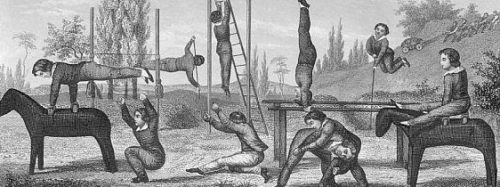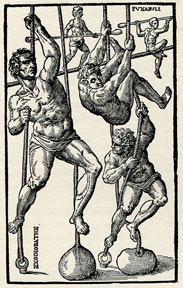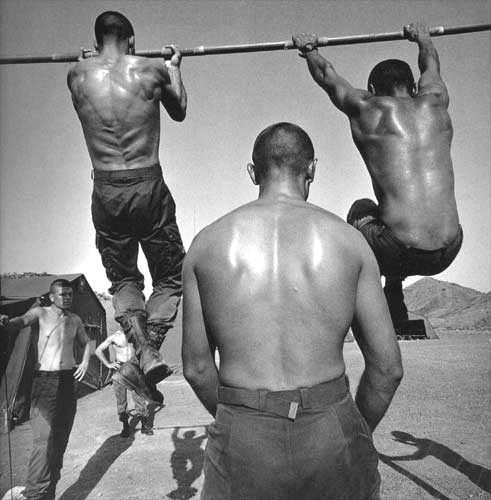As they say, the truth will set you free!! Nowhere is this freedom needed more than in the field of physical fitness training. Fortunately, the truth is not so difficult to find, especially when armed with a massive, foot-thick dictionary from 1946 and the oracle at Google! In this case, we are using language to trace the origins of the modern state of physical culture in the Western world. Before we jump in, I need to make it clear that this is meant to be a 10,000ft overview and a focus on some critical vocabulary. Hopefully it will stimulate you to do your own research into this fascinating subject!
The first word we must learn the old meaning to is “Gymnastic”. This word is critical to understanding a great many things. Let’s see if you pick up on them.
First, let’s begin with the word gymnastic itself. It is composed of two words, “gym” and “nastic.” “Gym” is short for gymnasium which is the place where gymnastic exercises are performed. Nastic means “short-breathed.” Thus, gymnastic exercise is performed in a gymnasium and makes you short of breath. Then there is the official definition:
Gymnastic, 2., plural. The art of developing by means of gymnastic exercises, bodily strength and agility : in modern usage referring more especially to exercises in a gymnasium as distinguished from athletics, exercises in the field.”
With this one definition, we see very clearly that gymnastic exercise differs from athletic exercise. The first distinction being that gymnastics are practiced indoors while athletics are practiced outdoors. This difference is important to understand. While athletics focuses primarily on locomotion (running and jumping), throwing and catching, gymnastic exercises are designed to strengthen the body and develop agility:
AGILITY, 1. the quality of being agile; quickness and readiness in movement; nimbleness.
This is a critical point of understanding. Gymnastic exercise is designed to impart the qualities of strength and agility to body movement. This, of course, is of great value to athletics or is simply a great way to maintain some level of physical performance and health.
As modern gymnastics evolved, it split into different sub-groups. As it did so, it also abandoned the obstacle negotiation focus it once had and the agility component, where it was retained at all, was highly specialized. Heavy gymnastics involved strength training with various apparatuses to include machines, clubs, rifles, kettlebells, barbells, dumbbells and more. Heavy gymnastics evolved into weightlifting and completely abandoned the agility component.
Light gymnastics came to become known as calisthenics and floor exercises. Primarily developed for women, light gymnastics excluded the use of any apparatus and have no agility component. Acrobatics focused on highly complex and technical routines performed on rings, bars, ropes and other apparatus but excluded strength training tools used in heavy gymnastics.
There was also the development of lower acrobatics which blended with dance. Lower acrobatics do not use apparatus and are composed of complex and technical body movements on the floor. However, these differ from floor gymnastics as seen in the Olympics. Also called Rhythmic Gymnastics, they are performed on a floor apparatus whereas lower acrobatics are performed on the real floor or ground.
Heavy gymnastics involved strength training with various apparatuses to include machines, clubs, rifles, kettlebells, barbells, dumbbells and more. Heavy gymnastics evolved into weightlifting and completely abandoned the agility component. Weightlifting evolved into powerlifting, Olympic weightlifting, bodybuilding, and a wide variety of related strength sports.
Light gymnastics came to become known as calisthenics and floor exercises. Primarily developed for women, light gymnastics excluded the use of any apparatus and have no agility component. There have been many variations of light gymnastics over the past 100 years but few have been truly popular.
Acrobatics focused on highly complex and technical routines performed on rings, bars, ropes and other apparatus but excluded strength training tools used in heavy gymnastics. technically speaking, modern gymnastics as seen in the Olympics is actually acrobatics. Furthermore, they are also collectively upper acrobatics as they are upright or suspended.
French Foreign Legionnaires
Lower acrobatics do not use apparatus and are composed of complex and technical body movements on the floor or ground. The highest lower acrobatics go is the standing position. Other names include ground moment skills, grass drills, guerilla drills, ground engagement drills, and individual movement techniques. They are a central component of many martial arts and many types of modern dance. Lower acrobatics differ from floor gymnastics as seen in the Olympics. Also called Rhythmic Gymnastics, these are performed on a specialized floor apparatus and the contestants remain predominantly upright.
Tumbling mixes elements of rhythmic gymnastics and lower acrobatics and involved very complex skills of jumping, rolling, diving, falling and overcoming obstacles. In modern days, tumbling has evolved into Parkour and Free Running while incorporating elements of obstacle negotiation.
Obstacle negotiation became almost exclusively the domain of the military by the late 1800s and is only now enjoying a revival in popularity. Obstacle negotiation is exactly what it sounds like and includes climbing and swimming.
What do all of these sects have in common? They are ALL gymnastics! They also exclude most locomotion, throwing, catching and manipulating objects (other than weights) as those are the domains of athletics. And yet, gymnastics and athletics cross over in many instances where gymnastic events are considered sports. The key difference of classical athletics is that they stressed locomotor and fighting (running, throwing, fighting). Classical athletic sports were complex, dynamic, often had a team component, required tactics and strategy and so on. Gymnastic sports like weightlifting are raw expressions of single attributes such as maximal strength or acrobatic skill on a set of rings. They also have little carry over to the real world or classical athletics, whereas classical gymnastics did.
It is also worthy to mention that classical gymnastics in the Greek era also involved intellectual development. The Greeks strongly believed that the mind and body must develop together and I for one agree 100%.
So where does that leave us today? In a word, confused… But with this knowledge, you will be able to begin seeing through the smoke and the fog of the “fitness industry” and understand why I label and classify activities the way I do. It all comes back to the original meanings and when you see it in that context the world feels right again, if only for a moment.
The Highland System of Combat & Survival is a manual of arms for training soldiers and armed professionals. It’s a complete set of concepts, skills, and training components to enhance one’s life and performance, especially in combat. Acquiring these skills, understanding the concepts and using the training components is the fastest and most effective way to improve the function of all twelve systems of our body and optimize all four levels of human ability; thus becoming the best version of yourself for life, sport or combat.
The key principle of The System is individual optimization. The goal is to ensure that training provides consistent improvement without harming you and that your psychological disposition doesn’t damage the body and psyche of you or your team. The system is designed to strengthen your mind, body, spirit and tactical capabilities to create a fully developed and highly capable person regardless of the task at hand (especially combat).
The System teaches you to understand and improve yourself as well as your family, community, state and nation. Knowing your strengths and weaknesses is good, but not fully sufficient. Training in The System is one of the sure ways to discover the full extent of your limitations and properly address them. Proper training in The System carries the objective of placing every person into the best possible setting to rapidly improve performance in every aspect at a rate that he/she is able to handle at that moment. In a simple and comprehensive way, The System helps you and guides you to become the very best version of yourself, far beyond any previous level of accomplishment.
By applying a carefully crafted blend of medical and sports sciences, The System is used to dramatically enhance the capability, capacity, technical skill level and resiliency of special operations troops and citizen-soldiers alike. The system is designed to always enhance and evolve these characteristics so that when the extraordinary occurs, you are able to draw from almost unlimited reserves and recover quickly and fully from the event(s). This has the effect of preserving the quality of life of the soldier, preserving families, extending the soldier’s service life, increasing combat effectiveness at all levels and ages, saving billions of dollars in medical treatment, and providing the nation with the highest level of capability possible. The Highland System is a new level of martial excellence for those who dare to be held to a higher standard.





[…] sbillh 8 mins ago 2 min read Learn more about this photo! […]